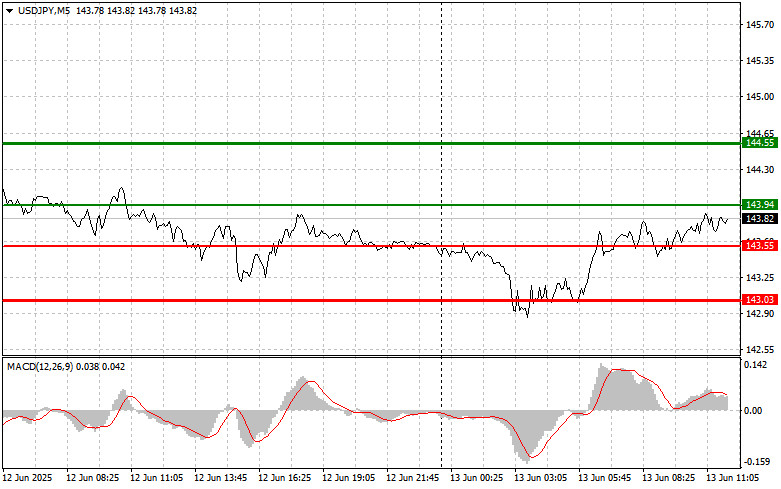USD/JPY: Simple Trading Tips for Beginner Traders – June 13th (U.S. Session)
Trade Review and Tips for Trading the Japanese Yen
None of the levels I marked were tested in the first half of the day, so I had no trades.
Given the brief calm in the Israel–Iran conflict, markets are catching their breath while awaiting news. If the conflict escalates, it could trigger a new wave of large-scale sell-offs in risk assets — including the Japanese yen. Investors are clearly acting with heightened caution, closely monitoring geopolitical indicators and preparing for potential volatility. The yen is influenced by its status as a safe-haven asset. In times of global instability, investors typically shift capital into safer instruments like the yen, leading to its appreciation. However, in the context of a potential military conflict, where uncertainty is extremely high, even safe-haven assets may face sell-offs.
As for the intraday strategy, I'll primarily rely on implementing Scenarios #1 and #2.

Buy Signal
Scenario #1:I plan to buy USD/JPY today upon reaching the entry point around 143.94 (green line on the chart), targeting a rise to 144.55 (thicker green line). At 144.55, I plan to exit long positions and open shorts in the opposite direction, aiming for a 30–35 point move down. A solid rally in the pair today is possible due to geopolitical developments.Important: Before buying, make sure the MACD indicator is above the zero line and just beginning to rise.
Scenario #2:I also plan to buy USD/JPY if the price tests 143.55 twice in a row while the MACD indicator is in the oversold zone. This would limit the downward potential and trigger a reversal upward. A rise toward the 143.94 and 144.55 levels can be expected.
Sell Signal
Scenario #1:I plan to sell USD/JPY today after a breakout below 143.55 (red line on the chart), which could lead to a quick drop. The key target for sellers will be 143.03, where I will exit short positions and open longs in the opposite direction, aiming for a 20–25 point rebound. Pressure on the pair is unlikely to return in full force today.Important: Before selling, make sure the MACD indicator is below the zero line and just beginning to decline.
Scenario #2:I also plan to sell USD/JPY if the price tests 143.94 twice in a row while the MACD indicator is in the overbought zone. This would limit the pair's upward potential and trigger a downward reversal. A drop toward the 143.55 and 143.03 levels can be expected.
On the Chart:
- Thin green line – entry price for buying the instrument
- Thick green line – suggested take-profit or profit-locking level, as further growth beyond this point is unlikely
- Thin red line – entry price for selling the instrument
- Thick red line – suggested take-profit or profit-locking level, as further decline beyond this point is unlikely
- MACD Indicator – Use overbought and oversold zones as guidance when entering the market
Important Note for Beginner Forex Traders:
Beginner traders must exercise extreme caution when making market entry decisions. It's best to stay out of the market ahead of major fundamental reports to avoid getting caught in sharp price movements. If you choose to trade during news releases, always set stop-loss orders to minimize losses. Without stop-losses, you can very quickly lose your entire deposit — especially if you trade large volumes without using proper money management.
And remember: successful trading requires a clear trading plan, like the one outlined above. Making spontaneous decisions based on the current market situation is inherently a losing strategy for intraday traders.
Market News